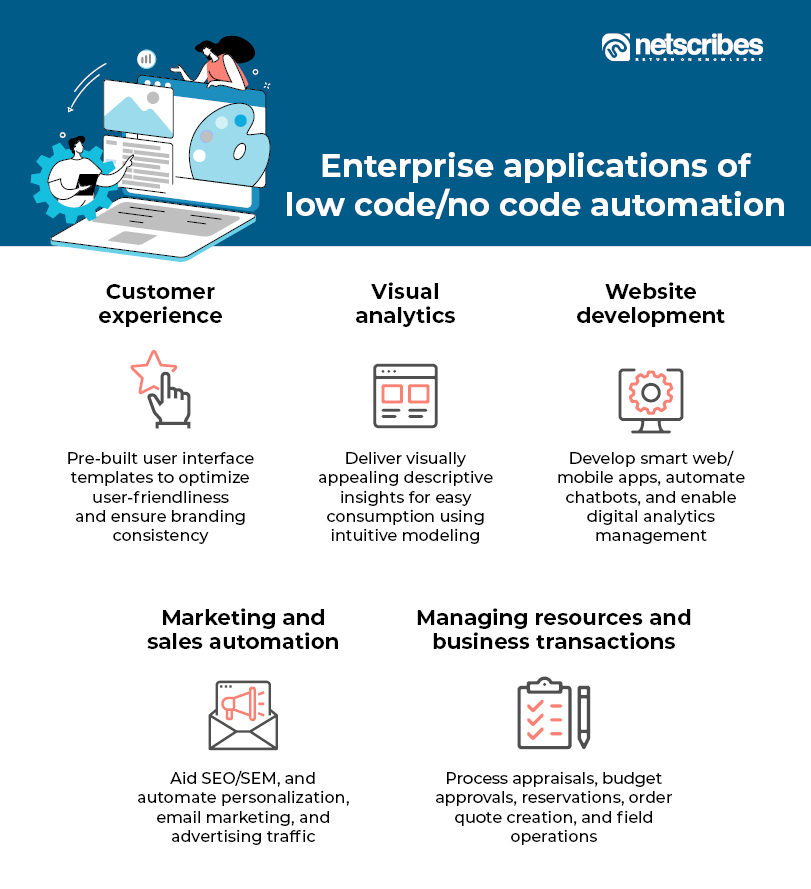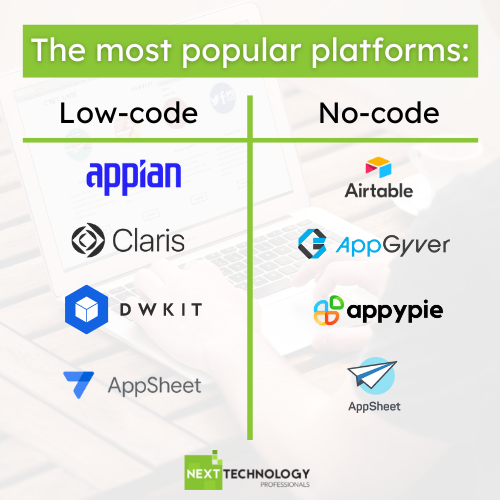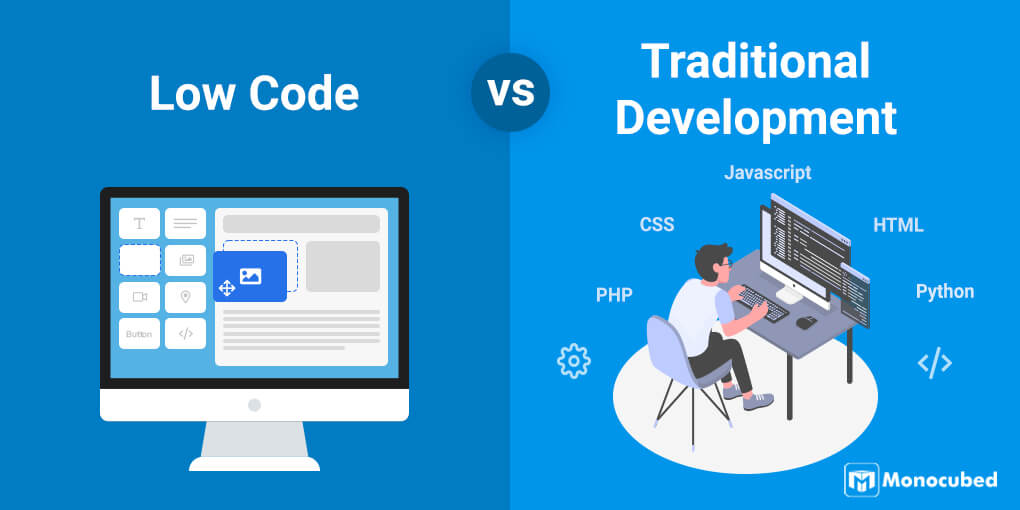Recommended Suggestions For Deciding On Low-Code Platform Sites
Wiki Article
The Advantages Of Low Code Application Development In Relation To Integration Capabilities
Low-code development is an excellent method of creating applications that integrate seamlessly with various platforms and services. These are the advantages of pre-built APIs and connectors:
An extensive range of connectors. Low-code software typically includes a wide range of pre-built connections for the enterprise system that are widely used (e.g. cloud services, databases, CRM). It makes it easier to integrate these systems.
API Integration - A lot of low-code platforms include API integration, which gives developers to easily access external data sources or services.
Simple to Use:
Drag-and--Drop integration Integration tasks are typically accomplished by using drag and-drop interfaces. Developers and non-developers can create complex integrated systems without having to write code.
Visual Workflow Designers: These software tools aid you in understanding and configuring integrations with greater ease.
Standardized Integration Methods:
SOAP and restful services: Supporting web service standard protocols like REST and SOAP makes integration simple with many different platforms and systems.
OData Standards: OData standards permit the simple manipulation and retrieval of data across various platforms and applications.
Real-Time Data Synchronization:
Real-time Integrations: Low-code systems allow real-time data synchronization between apps and systems, making sure that data is always up-to-date and consistent throughout the company.
Event-Driven architecture: Some platforms can support event-driven architectures. This lets applications react to events in real time, which is essential for interactive and dynamic applications.
Legacy System Integration:
Low-code platforms: These platforms can be used to connect old systems to the latest. They are a great way to upgrade your IT infrastructure without having to redesign everything.
Data Migration: Built-in tools help transfer data from older applications to the latest ones developed on platforms that use low-code.
Integration of Third Party Services:
Cloud Services Integration: The seamless integration of cloud services, like AWS Azure, Google Cloud makes it easy to deploy and scaling up of applications.
Business Applications Low-code platforms allow you to connect with a variety of business applications like Salesforce, SAP or Microsoft Dynamics. They enable the creation of a seamless workflow for all business processes.
Simplified Data Processing:
Unified Data Models: Some low-code platforms provide unification of data models which make it easier to manage managing data and integrating across multiple platforms.
Data Connectors are data connectors that have been pre-configured that provide easy access to sources of data, and allow manipulation.
Security and compliance
Secure Integrations: Low-code platforms ensure that integrations are compatible to security protocols and standards security standards, securing data in transport as well as at rest.
These platforms are usually equipped with features that ensure conformity (e.g. HIPAA, GDPR) and provide security to companies that handle sensitive data.
Extensibility:
Custom Code and Scripts : Low-code platforms tend to accommodate more complex integrations by allowing the inclusion of custom scripts and code. This allows flexibility without sacrificing the ease of use.
Plug-in Ecosystems : A system of extensions and plugins allow users to increase the integration capabilities. They can add new features as they need.
The overall low-code platform's integration capabilities makes it an effective tool for developing interconnected apps which are scalable and efficient. They make it easier for connecting disparate systems, enhance data flow, and enable businesses to leverage existing technologies while adopting new ones, which results in a cohesive and integrated IT environment. View the most popular I loved this for Low-code Platform for application development for site tips including app platforms, cross platform app dev, app platforms, cross platform mobile app development, app modernisation, rapid action development, rad application development, jdbc server, rapid action development, rapid applications and more.

Benefits Of Low-Code Application Development In Terms Of Governance And Security
Low-code development of applications offers a variety of benefits in terms of governance and security, which are essential for ensuring that applications are safe, secure, and well-managed throughout their lifespan. Here are the key benefits: Centralized Governance:
Unified Management console: Low-code platform typically provides a central dashboard where administrators can monitor and manage all apps and ensure that the governance is consistent across the organisation.
Role-Based Access Control RBAC : These platforms typically include access controls that are based on roles. They allow administrators define and enforce rules. This makes sure that only authorized users can access or modify particular areas of the application.
Compliance and Regulatory Adherence
The advantages of conformity: Many platforms that use low-code are built to conform to industry standards. These platforms provide frameworks and tools to make sure that the applications are compliant with these regulations.
Audit Trails: Many companies integrate comprehensive logging and audit trail systems, which allow the organization to monitor changes make, track access and assure the compliance of internal and external regulations.
Increased Security Measures:
Data Encryption : Low-code platform often offer built-in data encryption in transit and at rest. This means that data sensitive information is protected.
Security Certificates: Many low code providers have security certificate (e.g. ISO 27001 and SOC 2) which demonstrate that they are adhering to strict security standards. They offer an additional level of assurance to clients.
Automated Security Updates
Regular patching and updates: Low-code platforms handle most security patches and updates in a way. They ensure that applications are protected from the latest threats without having developers intervene manually.
Security Monitoring Tools: Tools for continuous security monitoring are included. They provide real-time alerts, as well as information about security concerns that could arise.
Data Governance
Data Access policies These platforms assist organizations define and apply their policies on data access, ensuring only authorized users are able to access data and that it is properly used.
Data Masking and anonymization The tools built into the system to mask and anonymize data help safeguard sensitive data in testing and development environments.
Consistent Lifecycle Management of Applications
Development and Deployment Pipelines: Low-code platforms often provide integrated development and deployment pipelines which include security checks, which ensure security remains intact throughout the entire application lifecycle.
Version Control: An integrated version control system can help track changes and allows any changes made to an application to be monitored. If needed, these can be reverted and the integrity of the application maintained.
User Authentication, Authorization, and Authorization
Single Sign-On (SSO) Single sign-on support as well as other advanced authentication mechanisms simplify management of users and improves security.
Multi-Factor Authentication (MFA) A number of platforms provide built-in support to multi-factor authentication. This adds an extra layer of security to access applications.
Policy Enforcement and Compliance Monitoring:
Policy Templates: Low-code platforms typically have templates for security and governance that allow organizations to quickly adopt policies.
Compliance Monitoring Tools: These tools provide regular monitoring and report on compliance status, making it much easier to recognize and resolve possible issues in advance.
Integration with Existing Security Infrastructure
Seamless Intergration: Low-code platforms are designed to allow seamless integration with security tools and equipment, like Identity Management Systems, SIEM Solutions (Security Information and Event Management), and Firewalls.
API Security: Built in API security features protect information, guarantee integrity of the application and ensure secure integrations.
Best Practices and Training:
Many platforms offer guides and best practice for developing secure applications. They assist non-developers to adhere to security standards.
Security Training: Certain providers of low-code provide training and resources on security to help users learn how to build and maintain secure applications.
Low-code development can provide a range of security and governance benefits that ensure applications are developed and managed in an efficient safe and secure manner. These platforms offer the necessary frameworks and tools to safeguard sensitive data and enforce policies, as well as maintain compliance with regulations while reducing management and oversight. Check out the best Enterprise application development with Low-code Platform for website tips including rapid application design, low code platforms, cross platform app development, mobile app development platforms, application modernization, develop mobile application, develop web application, rapid action development, cross platform mobile development, cross platform app dev and more.

Low-Code Apps Have Numerous Advantages When It Comes To Collaboration And Workflow
The low-code method of developing applications provides numerous advantages in terms of workflow and collaboration, which makes it a great option for businesses looking to increase team efficiency and streamlining their development processes. These are the major benefits.
Unified Development Environment (UDE): Low code platforms create one, unifying development environment that enables everyone on the team, including developers and business analysts to collaborate effectively. It eliminates silos while fostering more effective communication.
Visual Development: The low-code platform's visual drag-and-drop capabilities make it simple for team members who are not technical to participate to the design process. It also ensures that business requirements are captured correctly and then implemented.
Communication Enhancement:
Real-Time Collaboration: A lot of low-code platforms provide real-time collaboration capabilities, such as simultaneous editing, commenting and instant feedback, which enable continuous communication and cut down on the amount of time that is spent in back-and-forth discussions.
Shared workspaces: Teams can to work in tandem in shared workspaces where they can edit and discuss project elements. This will ensure that everyone is striving for the same objectives and are on the same level.
Streamlined Workflow:
Built-in Project Management Tools : Low code platforms often contain integrated software for managing projects that help teams organize, track, and manage, and coordinate their projects for development. This includes tasks management, progress tracking and management of deadlines.
Workflow Automation - Automating routine tasks or workflows permits teams to concentrate their efforts on more strategic initiatives and tasks and improves the overall efficiency of the organization.
More efficient Iteration cycles
Rapid prototyping. A low-code platform allows rapid prototyping. This allows feedback to be quickly integrated and improvements are made.
Support for Agile Development: Supporting agile methods allows teams to be continuously working in sprints. This makes it simpler to change and deliver smaller steps to improve functionalities.
Accessibility for those who are not developers
Citizen Development: Low code platforms enable users in the business (citizens developers) to develop and modify applications, without any prior knowledge of programming. This reduces the burden on IT and development departments and helps them react quicker to business demands.
Training and onboarding: Intuitive user interfaces and extensive training resources make it easier to bring new members of the team up to level. This improves the overall cohesion of the team.
Centralized documentation and knowledge sharing:
Documentation is integrated: Low code platforms usually come with the tools needed to create and manage documentation within the platform, making it simple for all project details to be centralized.
Knowledge Repositories: Teams can build knowledge repositories that include templates, best practices, and reusable components. This allows for sharing of knowledge and helps reduce duplication of effort.
Consistency and Standardization:
Standardized components: A standardized components that are pre-built ensure consistency in the applications. Team members can comprehend and work better with different components.
Governance and Compliance: Integrated into governance frameworks that ensure that every development adheres to the standards of the organization and regulatory needs, reducing risk of non-compliance and ensuring that applications meet high quality standards.
Feedback and Improvement Loops
Integrated Feedback Low-code platforms offer users with feedback mechanisms integrated into them that enable them to provide feedback easily on applications. Feedback from users can later integrated into the application development process.
Continuous Improvements: The ability for software to rapidly iterate and implement changes based off of user feedback, making sure that they are closely aligned to the needs of the user and the business goals.
Visualization and Reporting
Real-Time Analysis: Analytics and reporting tools built into the software provide real-time information on the progress of projects as well as user interactions and performance. This allows data-driven decision making.
Visual Workflow Analysis: Visual tools are used to visualize workflows and processes. These tools aid teams to analyze and improve their workflows.
Low-code application development has many benefits for collaboration and workflow. It is able to bring teams from different backgrounds into one space, simplify communication and streamline certain processes. This results in a more cooperative, efficient, and agile development environment, ultimately leading to higher-quality applications and better alignment with business objectives.
